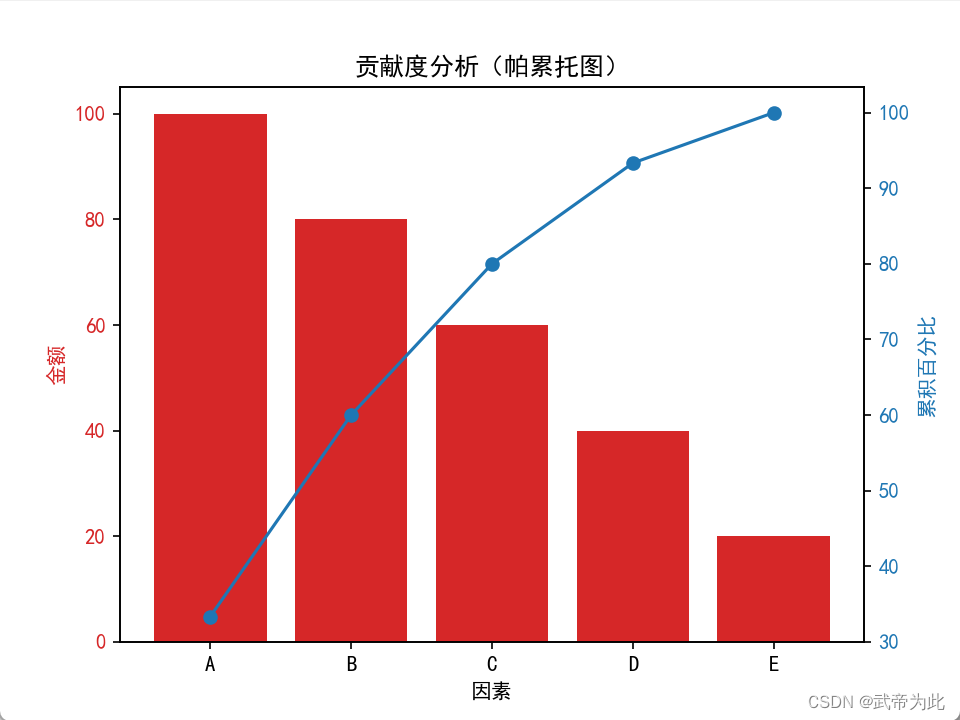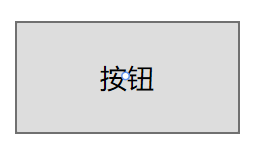目录
前言
为何学?
1.二叉搜索树是一种树形结构,是一种查找效率非常高的结构,值得我们去学习
2.map和set的底层也是二叉搜素树,学习二叉搜索树可以让我们更好的了解set和map的特性
一、二叉搜索树概念
二叉搜索树(BST,Binary Search Tree)又称二叉排序树、二叉查找树
它可以是一颗空树
如果不是,它(或者说它的任何一颗子树)必须满足下列条件:
1.如果它的左子树不为空,则左子树上的所有节点值都小于根节点的值
2.如果它的右子树不为空,则右子树上的所有节点值都大于根节点的值
3.左、右子树都是二叉搜索树
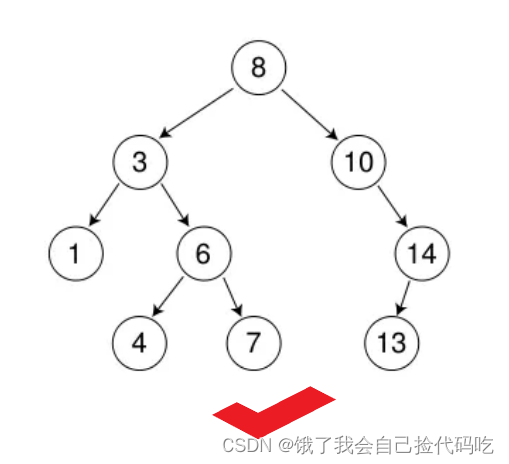
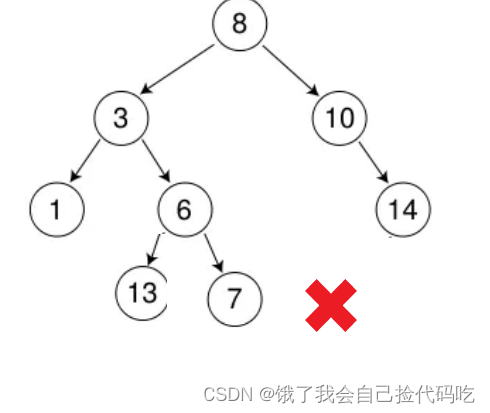
二、二叉搜索树的实现与操作
节点结构
template<class K>
struct BSTreeNode
{
typedef BSTreeNode<K> Node;
Node* _left;
Node* _right;
K _key;
BSTreeNode(const K& key)
:_left(nullptr)
, _right(nullptr)
, _key(key)
{}
};树类
template<class K, class V>
class BSTree
{
typedef BSTreeNode<K> Node;
public:
bool Insert(const K& key){}
bool Find(const K& key){}
bool Erase(const K& key){}
void _InOrder(Node* root){}
void InOrder()
{
_InOrder(root);
}
private:
Node* root = nullptr;
};
1.查找
从根开始查找比较,比当前根值大往右边查找,比当前根值大往右边查找,且最多查找高度次,走到空还未找到,则所查找值不存在
代码实现:
bool Find(const K& key)
{
Node* cur = _root;
while (cur)
{
if (cur->_key < key)
{
cur = cur->_right;
}
else if (cur->_key > key)
{
cur = cur->_left;
}
else
{
return true;
}
}
return false;
}2.插入
1.如果为空树,则将创建新节点,并将新节点赋值给根节点(root指针)
2.如果树不为空,则按二叉搜索树的性质先查找插入位置,再插入
bool Insert(const K& key)
{
if (_root == nullptr)
{
_root = new Node(key);
return true;
}
Node* parent = nullptr;
Node* cur = _root;
while (cur)
{
if (cur->_key < key)
{
parent = cur;
cur = cur->_right;
}
else if (cur->_key > key)
{
parent = cur;
cur = cur->_left;
}
else
{
return false;
}
}
cur = new Node(key);
if (parent->_key < key)
{
parent->_right = cur;
}
else
{
parent->_left = cur;
}
return true;
}3.删除
在二叉搜索树中删除是一个稍显麻烦的事,其中包含了许多细节
我们可以知道,待删除的节点有四种情景:
1.要删除的结点无孩子结点
2.要删除的结点只有左孩子结点
3.要删除的结点只有右孩子结点
4.要删除的结点有左、右孩子结点
在后面的处理中1情景和23情景可以融合,因此去掉1情景,我们有3种情景
- 情景2:使待删除节点的父节点指向待删除节点的左孩子,删除待删除节点
- 情景3:使待删除节点的父节点指向待删除节点的右孩子,删除待删除节点
- 情景4:
这里我们事用替换法删除--即在待删除节点的子树中找一个合适的替换节点,用它的值替换填补调待删除节点,可以找左子树的最大值或者右子树的最小值 ,在处理替换节点的子树问题
下面的演示代码找的树右子树的最小值替换:
bool Erase(const K& key)
{
Node* parent = nullptr;
Node* cur = _root;
while (cur)
{
if (cur->_key < key)
{
parent = cur;
cur = cur->_right;
}
else if (cur->_key > key)
{
parent = cur;
cur = cur->_left;
}
else
{
if (cur->_left == nullptr)
{
if (cur == _root)
{
_root = cur->_right;
}
else
{
if (cur == parent->_right)
{
parent->_right = cur->_right;
}
else
{
parent->_left = cur->_right;
}
}
delete cur;
return true;
}
else if (cur->_right == nullptr)
{
if (cur == _root)
{
_root = cur->_left;
}
else
{
if (cur == parent->_right)
{
parent->_right = cur->_left;
}
else
{
parent->_left = cur->_left;
}
}
delete cur;
return true;
}
else
{
// 替换法
Node* rightMinParent = cur;
Node* rightMin = cur->_right;
while (rightMin->_left)
{
rightMinParent = rightMin;
rightMin = rightMin->_left;
}
cur->_key = rightMin->_key;
if (rightMin == rightMinParent->_left)
rightMinParent->_left = rightMin->_right;
else
rightMinParent->_right = rightMin->_right;
delete rightMin;
return true;
}
}
}
return false;
}
4.中序遍历
既然二叉搜索树能叫做二叉排序树,自然是有原因的,在二叉搜索树中,对二叉搜索树来一次中序遍历,即可得到一组有序元素
在C++的类中,不能直接调用递归函数,需要嵌套一层递归
void InOrder()
{
_InOrder(_root);
cout << endl;
}
void _InOrder(Node* root)
{
if (root == nullptr)
return;
_InOrder(root->_left);
cout << root->_key << " ";
_InOrder(root->_right);
}5.完整代码
template<class K>
struct BSTreeNode
{
typedef BSTreeNode<K> Node;
Node* _left;
Node* _right;
K _key;
BSTreeNode(const K& key)
:_left(nullptr)
, _right(nullptr)
, _key(key)
{}
};
template<class K>
class BSTree
{
typedef BSTreeNode<K> Node;
public:
BSTree<K>& operator=(BSTree<K> t)
{
swap(_root, t._root);
return *this;
}
bool Insert(const K& key)
{
if (_root == nullptr)
{
_root = new Node(key);
return true;
}
Node* parent = nullptr;
Node* cur = _root;
while (cur)
{
if (cur->_key < key)
{
parent = cur;
cur = cur->_right;
}
else if (cur->_key > key)
{
parent = cur;
cur = cur->_left;
}
else
{
return false;
}
}
cur = new Node(key);
if (parent->_key < key)
{
parent->_right = cur;
}
else
{
parent->_left = cur;
}
return true;
}
bool Find(const K& key)
{
Node* cur = _root;
while (cur)
{
if (cur->_key < key)
{
cur = cur->_right;
}
else if (cur->_key > key)
{
cur = cur->_left;
}
else
{
return true;
}
}
return false;
}
bool Erase(const K& key)
{
Node* parent = nullptr;
Node* cur = _root;
while (cur)
{
if (cur->_key < key)
{
parent = cur;
cur = cur->_right;
}
else if (cur->_key > key)
{
parent = cur;
cur = cur->_left;
}
else
{
if (cur->_left == nullptr)
{
if (cur == _root)
{
_root = cur->_right;
}
else
{
if (cur == parent->_right)
{
parent->_right = cur->_right;
}
else
{
parent->_left = cur->_right;
}
}
delete cur;
return true;
}
else if (cur->_right == nullptr)
{
if (cur == _root)
{
_root = cur->_left;
}
else
{
if (cur == parent->_right)
{
parent->_right = cur->_left;
}
else
{
parent->_left = cur->_left;
}
}
delete cur;
return true;
}
else
{
// 替换法
Node* rightMinParent = cur;
Node* rightMin = cur->_right;
while (rightMin->_left)
{
rightMinParent = rightMin;
rightMin = rightMin->_left;
}
cur->_key = rightMin->_key;
if (rightMin == rightMinParent->_left)
rightMinParent->_left = rightMin->_right;
else
rightMinParent->_right = rightMin->_right;
delete rightMin;
return true;
}
}
}
return false;
}
void InOrder()
{
_InOrder(_root);
cout << endl;
}
void _InOrder(Node* root)
{
if (root == nullptr)
return;
_InOrder(root->_left);
cout << root->_key << " ";
_InOrder(root->_right);
}
private:
Node* _root = nullptr;
};
三、二叉搜索树的应用(K模型、KV模型)
1.K模型
K模型中只有一个key值作为关键码,只存储key值
如我们要在一个词库中搜索一个单词 “key”,我们只需要以这个词库的每一个单词作为key值构建二叉搜索树,再在这个树中查找key值为“key”的节点
2.KV模型
KV模型中的每一个key值都有一个对应的value值(也叫映射),即<Key,Value>键值对
如我们平时学习上经常用到的英汉词典,每个英文都对应着中文,英文单词与其对应的<Word,Chinese>就构成了一种键值对
下面就是上述K模型代码改造的KV模型代码
3.完整代码
template<class K, class V>
struct BSTreeNode
{
typedef BSTreeNode<K, V> Node;
Node* _left;
Node* _right;
K _key;
V _value;
BSTreeNode(const K& key, const V& value)
:_left(nullptr)
, _right(nullptr)
, _key(key)
, _value(value)
{}
};
template<class K, class V>
class BSTree
{
typedef BSTreeNode<K, V> Node;
public:
bool Insert(const K& key, const V& value)
{
if (_root == nullptr)
{
_root = new Node(key, value);
return true;
}
Node* parent = nullptr;
Node* cur = _root;
while (cur)
{
if (cur->_key < key)
{
parent = cur;
cur = cur->_right;
}
else if (cur->_key > key)
{
parent = cur;
cur = cur->_left;
}
else
{
return false;
}
}
cur = new Node(key, value);
if (parent->_key < key)
{
parent->_right = cur;
}
else
{
parent->_left = cur;
}
return true;
}
Node* Find(const K& key)
{
Node* cur = _root;
while (cur)
{
if (cur->_key < key)
{
cur = cur->_right;
}
else if (cur->_key > key)
{
cur = cur->_left;
}
else
{
return cur;
}
}
return nullptr;
}
bool Erase(const K& key)
{
Node* parent = nullptr;
Node* cur = _root;
while (cur)
{
if (cur->_key < key)
{
parent = cur;
cur = cur->_right;
}
else if (cur->_key > key)
{
parent = cur;
cur = cur->_left;
}
else
{
if (cur->_left == nullptr)
{
if (cur == _root)
{
_root = cur->_right;
}
else
{
if (cur == parent->_right)
{
parent->_right = cur->_right;
}
else
{
parent->_left = cur->_right;
}
}
delete cur;
return true;
}
else if (cur->_right == nullptr)
{
if (cur == _root)
{
_root = cur->_left;
}
else
{
if (cur == parent->_right)
{
parent->_right = cur->_left;
}
else
{
parent->_left = cur->_left;
}
}
delete cur;
return true;
}
else
{
// 替换法
Node* rightMinParent = cur;
Node* rightMin = cur->_right;
while (rightMin->_left)
{
rightMinParent = rightMin;
rightMin = rightMin->_left;
}
cur->_key = rightMin->_key;
if (rightMin == rightMinParent->_left)
rightMinParent->_left = rightMin->_right;
else
rightMinParent->_right = rightMin->_right;
delete rightMin;
return true;
}
}
}
return false;
}
void InOrder()
{
_InOrder(_root);
cout << endl;
}
private:
void _InOrder(Node* root)
{
if (root == nullptr)
return;
_InOrder(root->_left);
cout << root->_key << " ";
_InOrder(root->_right);
}
private:
Node* _root = nullptr;
};
四、二叉搜索树的性能分析
根据上面的介绍我们可以知道,无论是删除还是插入,都需要先查找到需要处理的位置,因此,查找效率代表了二叉搜索树的各个操作额性能
对于一个有n个节点的二叉搜索树,查找的平均长度差不多就是二叉搜索树的深度,节点越深,次数越多。
插入次序不同,得到的二叉搜索树的结构可能不同,比如下图:
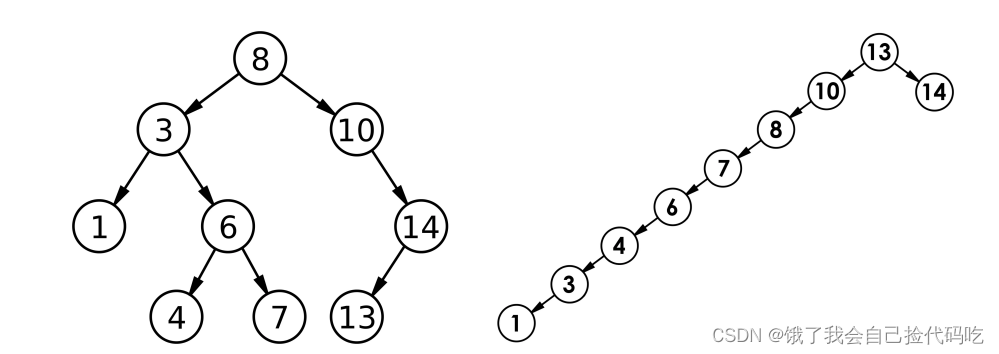
对于较好的情况参考上面的左图,二叉树为完全二叉树或者说接近完全二叉树,查找的平均次数为
对于较差的情况参考上面的右图,二叉搜索树退化成单只树或者说接近单只树,查找的平均次数为n
若是退化为单只树,二叉搜索树就失去了它的性能优势
要想二叉搜索树的性能不管怎样插入都能达到最优,请继续学习后面大佬们发明的AVL树和红黑树,在那里你可以找到所要的答案


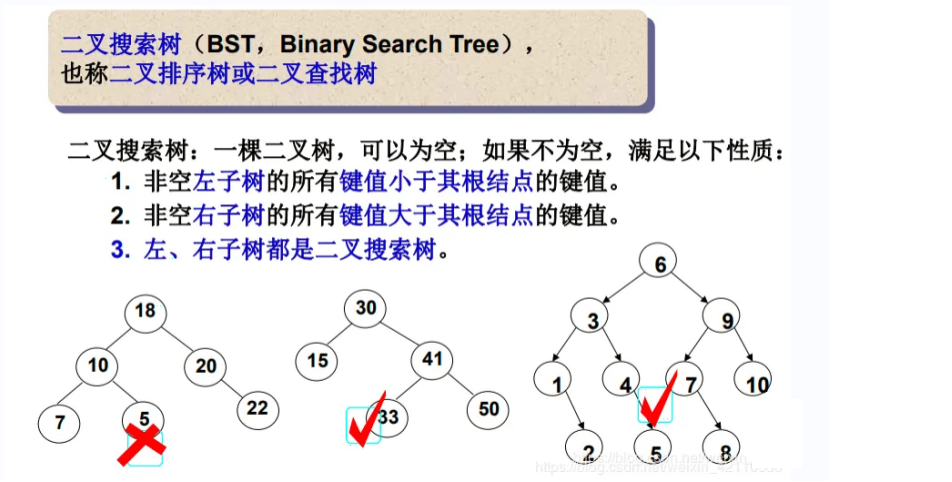


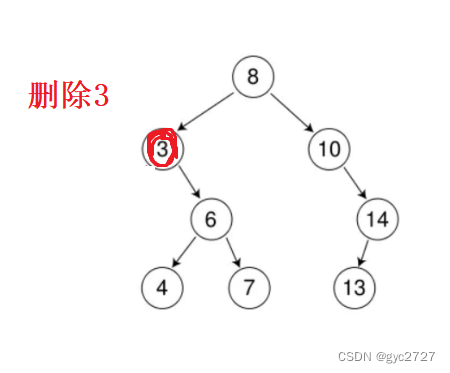

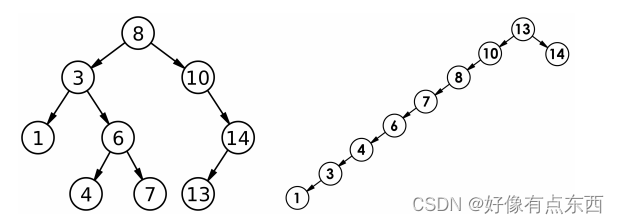
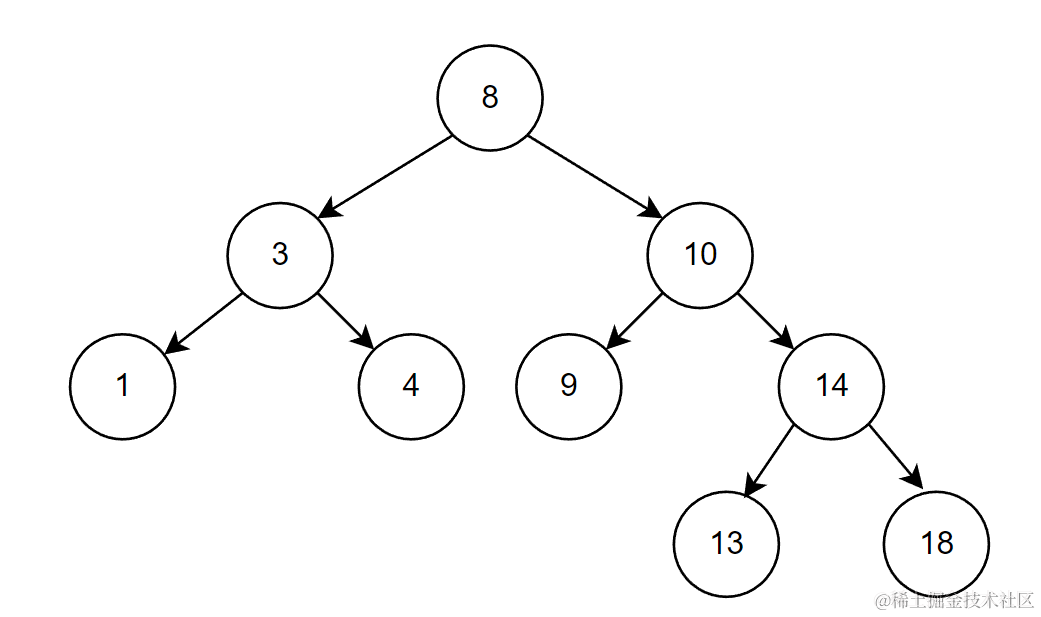

![[C++]<span style='color:red;'>二</span><span style='color:red;'>叉</span><span style='color:red;'>搜索</span><span style='color:red;'>树</span>](https://img-blog.csdnimg.cn/direct/6a5be3369a064765bb55ef13cb9d8460.png)























